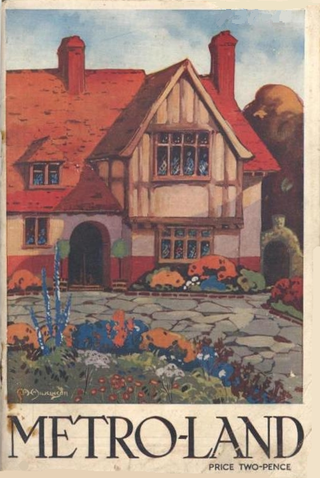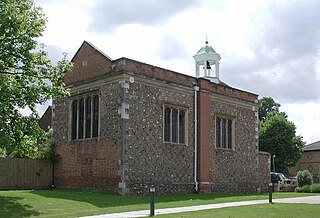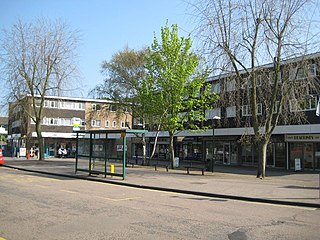
The Central line is a London Underground line that runs between Epping in Essex, and Ealing Broadway and West Ruislip in West London, via the East End, the City, and the West End. Printed in red on the Tube map, the line serves 49 stations over 46 miles (74 km), making it the network's longest line. It is one of only two lines on the Underground network to cross the Greater London boundary, the other being the Metropolitan line. One of London's deep-level railways traversing narrow tunnels, Central line trains are smaller than those on British main lines.

The Metropolitan line, colloquially known as the Met, is a London Underground line between Aldgate in the City of London and ‹See TfM›Amersham and Chesham in Buckinghamshire, with branches to Watford in Hertfordshire and Uxbridge in Hillingdon. Printed in magenta on the tube map, the line is 41.4 miles (66.7 km) in length and serves 34 stations. Between Aldgate and Finchley Road, the track is mostly in shallow "cut and cover" tunnels, apart from short sections at Barbican and Farringdon stations. The rest of the line is above ground, with a loading gauge of a similar size to those on main lines. Just under 94 million passenger journeys were made on the line in 2019.

Ruislip is a suburb in the London Borough of Hillingdon in West London. Prior to 1965 it was in Middlesex. Ruislip lies 13.8 miles (22.2 km) west-north-west of Charing Cross, London.

Watford is a town and borough in Hertfordshire, England, 15 miles (24 km) northwest of Central London, on the banks of the River Colne.

Watford Junction is a railway station serving the town of Watford in Hertfordshire, England. The station is on the West Coast Main Line (WCML), 17 miles 34 chains (28 km) from London Euston and the Abbey Line, a branch line to St Albans. It is also the northern terminus of the Lioness line of the London Overground, which operates via the Watford DC line into central London.

Harrow is a large town in Greater London, England, and serves as the principal settlement of the London Borough of Harrow. Lying about 9.5 miles (15.3 km) north-west of Charing Cross and 5.4 miles (8.7 km) south of Watford, the entire town including its localities had a population of 149,246 at the 2011 census, whereas the wider borough had a population of 250,149.

Metro-land is a name given to the suburban areas that were built to the north-west of London in the counties of Buckinghamshire, Hertfordshire and Middlesex in the early part of the 20th century that were served by the Metropolitan Railway ( ). The railway company was in the privileged position of being allowed to retain surplus land; from 1919 this was developed for housing by the nominally independent Metropolitan Railway Country Estates Limited (MRCE). The term "Metro-land" was coined by the Met's marketing department in 1915 when the Guide to the Extension Line became the Metro-land guide. It promoted a dream of a modern home in beautiful countryside with a fast railway service to central London until the Met was absorbed into the London Passenger Transport Board in 1933.

Leslie Thomas, OBE was a Welsh author best known for his comic novel The Virgin Soldiers.

The Chiltern Main Line is a railway line which links London and Birmingham on a 112-mile (180 km) route via High Wycombe, Bicester, Banbury, Leamington Spa and Solihull in England.

The Greenford branch line is a 2 miles 40 chains (4.0 km) Network Rail suburban railway line in west London, England. It runs northerly from a triangular junction with the Great Western Main Line west of West Ealing to a central bay platform at Greenford station, where it has cross-platform interchanges to the London Underground's Central line. A triangular junction near Greenford connects to the Acton–Northolt line. The line serves mainly the suburbs of Ealing and Greenford.

South Hampstead is a London Overground station on the Lioness line, situated on Loudoun Road in the London Borough of Camden. It is about 550 yards (500 m) south west of Swiss Cottage Underground station.

Watford Rural is a civil parish in the Three Rivers District of Hertfordshire, England. Located approximately 14 miles (23 km) northwest of central London and adjacent to the Greater London boundary, it is an urbanised parish characterised by suburban residential development. The local council is Watford Rural Parish Council. The parish covers South Oxhey and Carpenders Park, which although part of the Watford urban area, are outside the borough of Watford. The parish was created in 1894 when the ancient Watford parish was split into urban and rural parishes. At the 2011 census it had a population of 20,867.

Carpenders Park is a London Overground station on the Lioness line, located between the Hertfordshire suburb of Carpenders Park and the South Oxhey housing estate, 3 km (1.9 mi) south of Watford Junction. The station is an island platform reached by a subway. This has exits to both the Carpenders Park (east) and South Oxhey (west) estates.

The British Rail Class 501 electric multiple units were built in 1955/56 for use on the former LNWR/LMS suburban electric network of the London Midland Region. A total of 57 three-car units were built.

The Watford DC line is a suburban railway line from London Euston to Watford Junction in Greater London and Hertfordshire. Its services are operated by London Overground for the whole length of the line and the Bakerloo line of the London Underground between Harrow & Wealdstone and Queen's Park.

London Overground is a suburban rail network serving London and its environs. Established in 2007 to take over Silverlink Metro routes, it now serves a large part of Greater London as well as Hertfordshire, with 113 stations on the six lines that make up the network.

South Oxhey is an estate in the Watford Rural parish of the Three Rivers district of Hertfordshire, England. It is located in the south western corner of Hertfordshire and close to the boundary with Greater London. At the 2011 Census South Oxhey's population was included in the Northwick Ward of Three Rivers Council.

Carpenders Park is a suburb of Watford in the Watford Rural parish of the Three Rivers district of Hertfordshire, England. It is located in the south western corner of Hertfordshire and close to the boundary with Greater London. It is bounded to the West by a railway line that separates it from South Oxhey, to the East by the A4008 Watford to Harrow Road, to the South by the B4542, Green Belt and the boundary with the London Borough of Harrow and to the North by woodland.

The Acton–Northolt line (ANL), otherwise known as the New North Main Line (NNML), is a railway line in West London, England. Built between 1903 and 1906, it runs from the Great Western Main Line at Old Oak Common TMD to the Chiltern Main Line at South Ruislip, alongside the West Ruislip branch of the London Underground Central line, for a distance of around 11 miles (18 km).



















